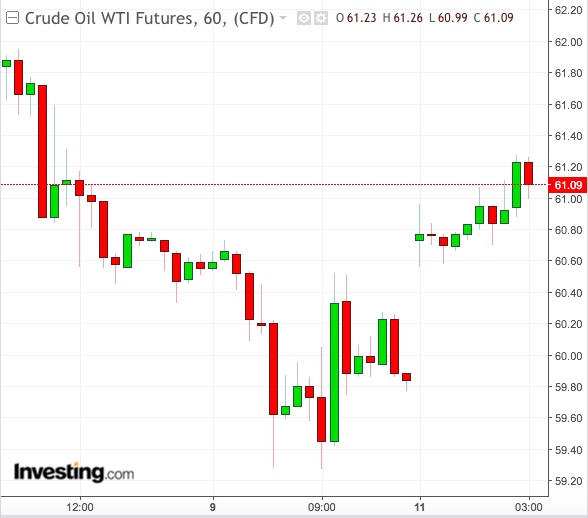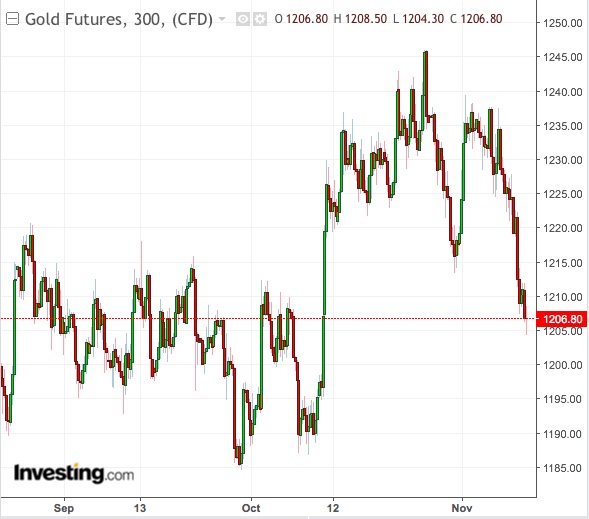Oil prices were up strongly in early Asia trade on Monday after Saudi Arabia, the world’s leading crude exporter, announced plans over the weekend to reduce a half million barrels from its daily output, in an effort to end the selloff that erased a fifth of the market’s value in five weeks. But prices could weaken again if disappointment grows among traders looking for bigger cuts from the Organization of the Petroleum Exporting Countries (OPEC).
Gold is another commodity that, this week, could be targeted by bears that see little upside for the yellow metal, amid a string of US rate hikes on tap.
After Friday’s outsize growth in the US producer price index, a ramp-up in forthcoming consumer price index (CPI) and retail sales data could further inflate the dollar, spelling trouble for most commodities priced in the global reserve currency. Aside from US data, investors also have eurozone CPI and GDP numbers to contend with this week.
If risk-off continues in energy and metals, long-only commodity investors may find some solace in agricultural markets, with crop price forecaster Shawn Hackett reporting short-term buy signals in soybeans, soymeal, wheat, cotton, orange juice and lumber.
OPEC May Seek To Act Urgently

In oil, world benchmark UK Brent rallied more than 1 percent as the week began in Asia and prices of US West Texas Intermediate (WTI) crude rose too. On Friday, Brent broke below the $70 support it had held since May, while WTI slumped beneath the $60 level maintained since March.
But some, like Dominick Chirichella of the Energy Management Institute in New York, continue to express skepticism. Chirichella said in a note:
“I am maintaining my overall oil view and short-term bias at cautiously bearish. The current fundamentals are becoming less supportive as supply and demand may not be as impacted by Iranian sanctions as the market originally estimated.”
Saudi Energy Minister Khalid al-Falih announced at the weekend that oil supplies from the Kingdom were expected to be about 0.5 million barrels per day (bpd) lower in December.
While the Saudi announcement gave an immediate boost to crude prices, it could still disappoint traders looking for cuts of as much as 1.0 million bpd from OPEC to offset higher supplies resulting from generous US waivers on Iranian oil sanctions.
Falih chaired a meeting of the so-called “Joint OPEC and Non-OPEC Market Monitoring Committee” in Abu Dhabi this past weekend. But there were no immediate signs that attendees other than Saudi Arabia, including non-OPEC member Russia, were keen to cut supplies. The Saudi reductions might also be more of a seasonal event, with Falih acknowledging December as a slow period for demand.
While the OPEC group might have missed an opportunity to act, production cuts will most likely top the agenda at the next, more important policy-setting meeting on December 6 in Vienna.
OPEC's last round of cuts began in January 2017 when oil prices were emerging from the rut of the 2014-originated US shale glut that drove crude prices down to nearly $25 a barrel. While the reductions were supposed to last until the end of 2018, the group prematurely ended them when prices began rallying sharply from late 2017. This time again, OPEC’s hand is being forced somewhat by US crude production, now at a weekly record high of 11.6 million bpd.
Gold’s $1,200 Support At Risk

In gold, the $1,200 support that had been the market’s bedrock for the past two months could be broken this week after US PPI data on Friday became an endorsement of the Federal Reserve's intention to raise interest rates again in December.
The Fed has already hiked rates three times this year and is determined to stay ahead of the inflationary curve with more increases in 2019 after the robust growth seen lately in the US economy. Rate hikes typically boost the dollar, which is a contrarian bet to gold.
The Dollar Index, which measures the greenback’s strength against a basket of six major currencies, shot up 0.22% on Friday, finishing with a fourth straight week of gains. TD Securities said it expected gold to lose more of its safe haven appeal this week and the dollar to become the hedge of choice for investors optimistic about the US economy.
US gold futures for December delivery settled down $16.50, or 1.3%, at $1,208.60 per troy ounce on Friday. That was the sharpest one-day loss in gold futures since August 15. The session bottom was $1,207.30—the lowest in four weeks. Analysts at TD Securities said in a note:
“With tail-risks out of the way, we would not be surprised to see gold resume its downward trajectory for now.”
